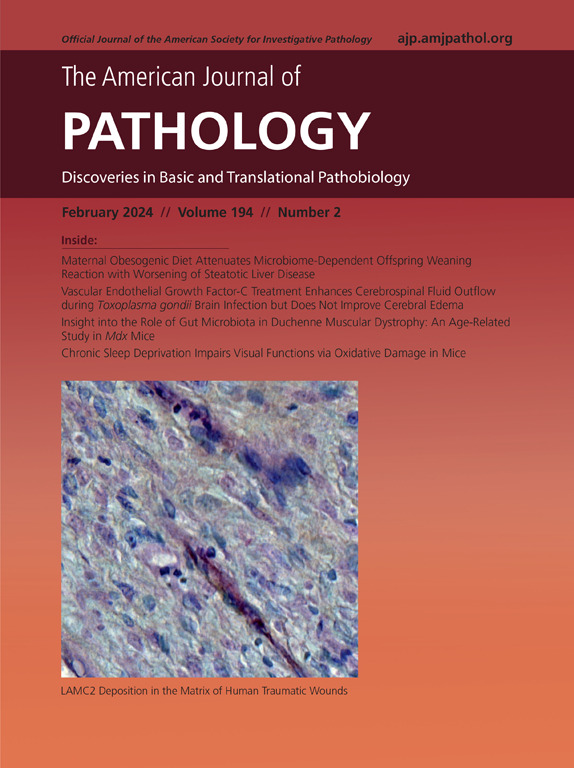Peroxisome Proliferator–Activated Receptor Agonist IVA337 Alleviates Inflammation and Fibrosis in MASH by Restoring Lipid Homeostasis
IF 3.6
2区 医学
Q1 PATHOLOGY
引用次数: 0
Abstract
Metabolic dysfunction–associated steatohepatitis (MASH), an advanced stage of metabolic dysfunction–associated steatotic liver disease, is characterized by significant hepatic fibrosis and inflammation. The pan-peroxisome proliferator–activated receptor (pan-PPAR) agonist IVA337 (lanifibranor) has shown potential as an anti-MASH therapeutic, although its mechanisms of action remain incompletely understood. This study explores the effects and mechanisms of IVA337 using two distinct MASH models: two-dimensional (2D) primary human hepatic stellate cells (HSCs) stimulated with transforming growth factor β1 (TGF-β1), and three-dimensional (3D) liver spheroids comprising primary hepatocytes, HSCs, and non-parenchymal cells. In TGF-β1–stimulated HSCs, IVA337 effectively suppressed the expression of fibrosis-related genes, including PAI1, COL1A1, and ACAT2, as well as the inflammatory gene IL6. 3D mouse and human liver spheroid models of MASH, characterized by elevated fibrotic gene expression, were established. IVA337 treatment not only attenuated fibrotic gene expression but also restored lipid content in the MASH spheroids, as evidenced by BODIPY staining. Immunostaining further confirmed a reduction in α-smooth muscle actin and collagen 1 levels after IVA337 treatment. Bulk RNA sequencing and Gene Ontology analysis revealed several lipid metabolism–related genes as key effectors downstream of IVA337. In addition, IVA337 modulated multiple signaling pathways, including IL-17, tumor necrosis factor, NF-κB, phosphatidylinositol 3 kinase/protein kinase B, and mitogen-activated protein kinase. Collectively, these findings show that IVA337 effectively mitigates fibrosis development in both 2D and 3D MASH models by restoring lipid homeostasis and regulating crucial fibrotic and inflammatory pathways.
过氧化物酶体增殖物激活受体激动剂IVA337通过恢复脂质稳态减轻MASH的炎症和纤维化。
代谢功能障碍相关脂肪性肝炎(MASH)是代谢功能障碍相关脂肪性肝病(MASLD)的晚期,以显著的肝纤维化和炎症为特征。泛过氧化物酶体增殖激活受体(pan-PPAR)激动剂IVA337 (lanifbranor)已被证明具有抗mash治疗的潜力,尽管其作用机制尚不完全清楚。本研究通过两种不同的MASH模型探讨了IVA337的作用和机制:TGFß1刺激的2D原代人肝星状细胞(hsc)和由原代肝细胞、hsc和非实质细胞(npc)组成的3D肝球体。在tgf ß1刺激的hsc中,IVA337有效抑制了包括PAI1、COL1A1、ACAT2在内的纤维化相关基因以及炎症基因IL-6的表达。我们成功地建立了三维小鼠和人肝脏球体模型,其特征是纤维化基因表达升高。BODIPY染色证实,IVA337治疗不仅降低了纤维化基因的表达,而且恢复了MASH球体的脂质含量。免疫染色进一步证实IVA337治疗后α - sma和胶原- 1水平降低。大量RNA测序和基因本体(GO)分析显示,几个脂质代谢相关基因是IVA337下游的关键效应基因。此外,IVA337调节多种信号通路,包括IL-17、TNF、NF-kappa B、PI3K-AKT和MAPK。总之,这些发现表明,IVA337通过恢复脂质稳态和调节关键的纤维化和炎症途径,有效地减轻了2D和3D MASH模型中的纤维化发展。
本文章由计算机程序翻译,如有差异,请以英文原文为准。
求助全文
约1分钟内获得全文
求助全文
来源期刊
CiteScore
11.40
自引率
0.00%
发文量
178
审稿时长
30 days
期刊介绍:
The American Journal of Pathology, official journal of the American Society for Investigative Pathology, published by Elsevier, Inc., seeks high-quality original research reports, reviews, and commentaries related to the molecular and cellular basis of disease. The editors will consider basic, translational, and clinical investigations that directly address mechanisms of pathogenesis or provide a foundation for future mechanistic inquiries. Examples of such foundational investigations include data mining, identification of biomarkers, molecular pathology, and discovery research. Foundational studies that incorporate deep learning and artificial intelligence are also welcome. High priority is given to studies of human disease and relevant experimental models using molecular, cellular, and organismal approaches.

 求助内容:
求助内容: 应助结果提醒方式:
应助结果提醒方式:


